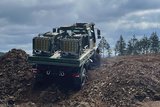Raytheon provides tactical networked communications in Indian military field demonstration
Raytheon Company has successfully proved its tactical networked communications capabilities using the Enhanced Position Location Reporting System-Extended Frequency-International (EPLRS-XF-I) during a second-phase field demonstration in support of India's modernization efforts.
System performance during the April 2010 demo was marked by a highly reliable 2-Mbps (millions of bits per second or megabits per second) - the first time this has been demonstrated with EPLRS internationally - across distances exceeding 30 km (18.6 miles), using stationary as well as mobile nodes. It provided for the simultaneous voice, video and data communication, yet in an easy-to-use, simplified architecture.
"Working with Precision Electronics Limited of Noida, India, we have shown Bharat Electronics Limited and the Indian Ministry of Defence that the EPLRS family of radios provides a tailored, low-risk netted communications solution to meet specific MoD requirements," said Brian McKeon, vice president, Raytheon Network Centric Systems Integrated Communications Systems.
The demonstration featured networked communications for a battlefield surveillance solution. The versatile communications unit supplied a secure, wireless network system in static and mobile operating environments where the network infrastructure did not initially exist.
EPLRS is one of the most widely used tactical wireless networks today, with more than 25,000 units fielded across the US armed services, Canada and Australia. The XF-I system uses the most advanced EPLRS waveform available for communications, critical position location information and effective electronic counter-countermeasures. It provides a robust, self-healing network that automatically adapts to network changes, including in difficult urban environments.
Source: Raytheon
More from Digital Battlespace
-
![Babcock nears first customer for Nomad AI translation tool]()
Babcock nears first customer for Nomad AI translation tool
Nomad can provide militaries with real-time intelligence, saving critical time on the battlefield.
-
![AUSA 2025: Israel’s Asio Technologies to supply hundreds of improved Taurus tactical systems]()
AUSA 2025: Israel’s Asio Technologies to supply hundreds of improved Taurus tactical systems
Taurus operates alongside the Israel Defense Forces’ Orion system which supports mission management across tens of thousands of manoeuvring forces, from squad leaders to battalion commanders.
-
![AUSA 2025: Kopin pushes micro-LED plans as China moves faster]()
AUSA 2025: Kopin pushes micro-LED plans as China moves faster
The plan for the new displays follows fresh investment in Kopin’s European facilities by Theon and an order for head-up displays in fielded aircraft, with funding from the US Department of Defense.
-
![AUSA 2025: Persistent Systems to complete its largest order by year’s end]()
AUSA 2025: Persistent Systems to complete its largest order by year’s end
Persistent Systems received its largest ever single order for its MPU5 devices and other systems earlier this month and has already delivered the 50 units to the US Army’s 4th Infantry Division.
-
![Aselsan brings in dozens of companies and systems under the Steel Dome umbrella]()
Aselsan brings in dozens of companies and systems under the Steel Dome umbrella
Turkey has joined the family of countries attempting to establish a multilayered air defence system with government approval in August 2024 for the effort landed by Aselsan. Dubbed Steel Dome, the programme joins Israel’s Iron Dome, the US Golden Dome, India’s Mission Sudarshan Chakra and South Korea’s low-altitude missile defence system.
-
![DSEI 2025: MARSS unveils new agnostic multidomain C4 system]()
DSEI 2025: MARSS unveils new agnostic multidomain C4 system
MARSS’ NiDAR system has been deployed using sensors from static platforms to provide detection and protection for static sights, such as critical infrastructure, ports and military bases.



























